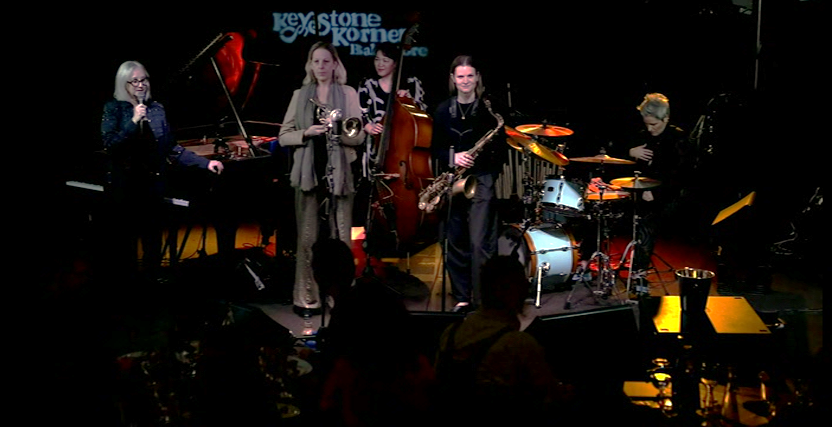
ARTISTS: Artemis
DATE: March 13, 2025
VENUE: Keystone Korner, Baltimore
PERSONNEL: Ingrid Jensen (tp); Nicole Glover (ts); Renee Rosnes (p); Noriko Ueda (b); Allison Miller (d).
As any member of a performing group will affirm, there is no substitute for playing together. And when that group plays together on several consecutive days, the improvements in ensemble playing and interaction increase many times over. When the jazz supergroup Artemis came to Baltimore for a one-nighter at Keystone Korner, they had just completed a week-long stand at the Village Vanguard. As I was not in New York for the earlier engagement, I can’t pinpoint any specific changes that may have occurred at that fabled club, but I can say with certainty that the chemistry between Ingrid Jensen and Nicole Glover now stands at an equal level as that of the stellar rhythm section of Renee Rosnes, Noriko Ueda, and Allison Miller. Ignoring the usual divisions of horns and rhythm, the band interacts with nearly telepathic speed. Meanwhile, the tremendous book of arrangements continues to grow and evolve.
After a free introduction (including a Stravinsky quote from Rosnes), Artemis charged into an energetic version of the pianist’s “Galapagos”. Glover led the solos with an exploration of the harmony, and Jensen fed off the growing intensity with a blazing invention that spanned the range of her horn from rich low tones through the lyric middle range to brilliant flourishes in the high register. With Ueda and Miller building the intensity, Rosnes created a tempest at the piano, filled with long runs up and down the keyboard along with several riffs and tremolos added to the maelstrom. Miller topped it all off with a thunderous solo powered by a seemingly endless reserve of energy. Artemis has just released “Arboresque“, their third album on Blue Note. As in the Keystone performance, the album includes originals from every member of the group. Many of these originals, including Ueda’s “Komorebi” and Glover’s “Petrichor”, feature the same type of relaxed moods found on late-60s Blue Note albums. At the Keystone, these originals were placed on either side of Rosnes’ witty re-composition of Thelonious Monk‘s “Hackensack” and the tune sequence brought refreshing variety of styles without sacrificing the set’s momentum. Jensen concentrated on the middle register while playing over Ueda’s piece (and surprisingly, did not solo at all on the Monk or Glover works). Glover built impressive solos on the Ueda and Monk pieces by developing motivic ideas and taking additional inspiration from the rhythm section’s interaction. Ueda displayed great fluidity and clear tones when soloing on her own piece, and her free-wheeling duet with Miller on “Hackensack” was one of that tune’s many highlights (Another highlight came in Rosnes’ quotes of other Monk themes, including “Misterioso”, “I Mean You” and “Green Chimneys”). I have heard Artemis play this chart a few times over the past two years, with new elements added each time. Perhaps the work’s continuing evolution is the reason why it hasn’t appeared on any of the group’s albums. No one in the audience—except for the club’s bartender—knew that “Petrichor” referred to the smell of rain, but Glover’s delicate composition evoked that very familiar and welcome scent. The composer presented a gorgeous reading of her melody with Jensen’s muted trumpet and Rosnes’ sensitive keyboard in support. The rhythm section’s accompaniment to the gentle solos by Rosnes and Glover ebbed and flowed without obstructing the main improvisations. Jensen’s “Sights Unseen” has a highly-structured melodic line based on angular motives. The solo section is free-bop, leaving many options for expressive improvisation. Jensen’s solo started in the middle register but before long she moved skyward to fire off several dazzling runs. Glover, whose confidence has grown exponentially since she joined this band, grabbed Jensen’s final flurry to create a thrilling invention which weaved and bobbed around Miller’s multi-layered background. Following a sparkling solo by Rosnes, there was a brief episode of group interaction. Miller’s “Little Cranberry” was composed after a summer vacation in Maine. The rhythm section supported the piece with a gently undulating rhythm, and the solos by piano and tenor were peaceful and lyric. The closing trumpet solo was played over a vamp in the piano and bass, and hand-played tenor drum by the composer.
The final section of the single set focused on Rosnes’ settings of the Burt Bacharach pop classic “What the World Needs Now is Love”, Wayne Shorter‘s “Footprints” and—as an encore—Billy Strayhorn‘s “A Flower is a Lovesome Thing”. A note on the cover of the new CD acknowledges Mulgrew Miller‘s arrangement of the Bacharach song. Rosnes’ chart retains the tender reharmonization and lilting flow of Mulgrew’s original arrangement, while adding intriguing structural changes and enhanced harmonies. Rosnes opened the performance with an extended pastorale, which Jensen followed with a dramatic muted solo. Glover’s sweepingly lyric tenor provided an emotional high point, and a brief statement from Ueda continued under a restatement of the melody. Rosnes soloed again as the dynamics swelled into a brief coda. “Footprints” is another arrangement that has evolved in the past year. The current version includes a pentatonic counter-melody which drops between the phrases of Shorter’s original tune. The solos are now set over a free vamp, rather than the original blues progression. Glover showed her allegiance to John Coltrane with a dynamic solo. Another melodic line appeared before a thrilling set of exchanges between Jensen and Rosnes, which were determined on phrase lengths rather than the standard 4- or 8-bar trade-offs. The final choruses of the arrangement mixed more original melodies over a rhythmically-shifted version of Shorter’s original background riff. The Strayhorn was the perfect ending to the concert: understated, sensitive, and ravishingly beautiful.
While studio recordings rarely reach the lofty heights of live performance, the new Artemis album “Arboresque” actually comes fairly  close. The audio fidelity is exquisite, which allows listeners to witness the band’s outstanding interaction. The playlist includes two compositions not discussed above, the highly descriptive “The Smile of the Snake” by the inexplicably obscure pianist Donald Brown, and a propulsive Rosnes original called “Olive Branch”. The solo section of “Sights Unseen” uses a different chord structure, and Jensen plays a poignant muted solo on “Petrichor”. “Footprints” and “What the World Needs Now” contain minor differences between the studio and live arrangements, while the remaining originals sound quite similar to their current live versions. Naturally, the solos on the album are different—and shorter, which offers another salient point: like all great jazz musicians, the members of Artemis can invent amazing long solos, but the studio album reveals that they can create short solos that are just as memorable. So, whether or not a live concert by Artemis is scheduled near you, pick up the album. Satisfaction guaranteed!
close. The audio fidelity is exquisite, which allows listeners to witness the band’s outstanding interaction. The playlist includes two compositions not discussed above, the highly descriptive “The Smile of the Snake” by the inexplicably obscure pianist Donald Brown, and a propulsive Rosnes original called “Olive Branch”. The solo section of “Sights Unseen” uses a different chord structure, and Jensen plays a poignant muted solo on “Petrichor”. “Footprints” and “What the World Needs Now” contain minor differences between the studio and live arrangements, while the remaining originals sound quite similar to their current live versions. Naturally, the solos on the album are different—and shorter, which offers another salient point: like all great jazz musicians, the members of Artemis can invent amazing long solos, but the studio album reveals that they can create short solos that are just as memorable. So, whether or not a live concert by Artemis is scheduled near you, pick up the album. Satisfaction guaranteed!
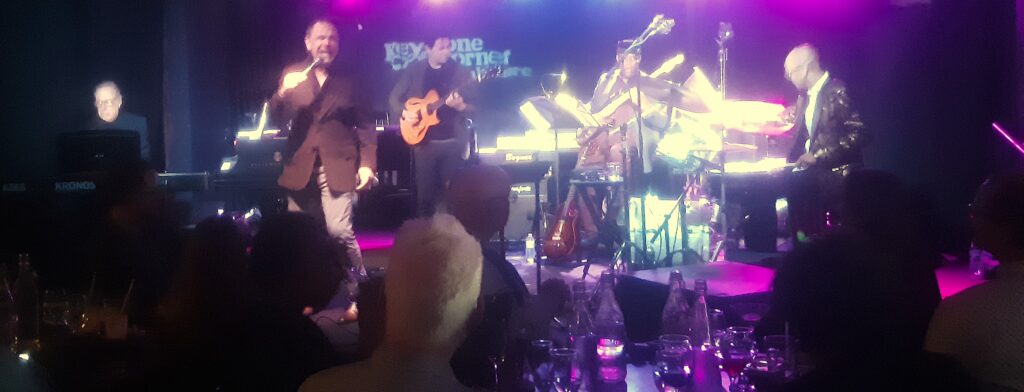
ARTIST: Kurt Elling
DATE: April 5, 2025
VENUE: Keystone Korner, Baltimore
PERSONNEL: Kurt Elling (v); Yaron Gershovsky (p,kyb); Mike Moreno (g); Essiet Okon Essiet (b); Marcus Finnie (d).
It is quite an audacious task for a jazz vocalist to perform a tribute concert to a fusion band. But when that vocalist happens to be Kurt Elling and the honored band is Weather Report, the resulting program cannot help from being challenging and esoteric. Elling has performed and recorded some of his favorite Weather Report pieces over the past eight years, and at Baltimore’s Keystone Korner, Elling and his tightly-rehearsed quartet performed a half-dozen lesser-known (but outstanding) compositions of Wayne Shorter, Joe Zawinul and Jaco Pastorius. Not content with a “greatest hits” repertoire, Elling’s tribute put aside familiar compositions like “A Remark You Made”, “Volcano for Hire”, “Mysterious Traveler” and—most notably—”Birdland” (the latter’s absence can be explained with at least two reasons: first, Jon Hendricks wrote a full lyric with vocalese, and second, it’s not too cool to appear at a jazz club to sing a song about another club that is still operating).
The set began with a powerful arrangement of “Elegant People”. Elling ascended to the stage, and scatted a few phrases over the introductory vamp before leading into his original lyrics for Shorter’s theme and tenor sax solo. Elling’s dynamic performance (and an overmodulating sound system) obscured the words at times, but his passion was clear with or without lyrics. Guitarist Mike Moreno performed the first of several outstanding solos, and the band maintained a tight and vibrant groove. Marcus Finnie‘s explosive drum solo pushed the intensity higher before Elling reprised the melody. The spoken introduction to Pastorius’ “Continuum” became a miniature sermon as Elling preached in a stunning stream-of-consciousness style which suddenly changed to an unaccompanied vocal prelude (How does Elling pull opening pitches out of the air? I never asked him if he had perfect pitch). When the band entered, Elling sang about light, love and enigmas over a stately background. Gershovsky‘s piano solo was virtuosic, with full octaves in the left hand against rich chords in the right (Incidentally, the Keystone gig was the pianist’s debut on this repertoire with Elling. The former musical director for Manhattan Transfer performed with great precision and confidence). “Three Views of a Secret” combines Pastorius’ music and poetry from the medieval poet Rumi. Essiet Okon Essiet opened the slow waltz with sturdy support for the emotional vocal. After a fine Moreno solo, Elling performed a remarkable vocalese that spanned across his vocal range, and demanded an energic delivery. The sheer technique required for this extended passage is phenomenal, and I was amazed at Elling’s incredible vocal stamina, especially when performing this piece at the center of the set.
An extended solo from Essiet opened the most familiar of the Weather Report songs, “Black Market”. Elling scatted the melody, doubled by Gershovsky’s synthesizer, before segueing to a rhythmical improvisation. A series of exchanges by guitar and keyboard followed, accompanied by a tight funk beat augmented with Elling on tambourine. “Current Affairs” was Elling’s earliest WR vocalese and he told the audience about Zawinul’s unique reaction when meeting Elling at a Hollywood party. The song was incredibly tender, with Gershovsky providing a sensitive accompaniment for the opening section. The vocalese enhanced Zawinul’s melody while the gospel style of the background made the piece into a spiritual experience. The closer, “Palladium” featured another new Elling lyric for the melody, and a brilliant duet with Elling scatting percussive drum patterns against Finnie’s energetic responses from his drum kit. The audience begged for an encore, but it never came. And perhaps that was best, considering the overwhelming density of the set.
In addition to the Weather Report tour and his collaboration with guitarist Charlie Hunter, Superblue, Elling launched another intriguing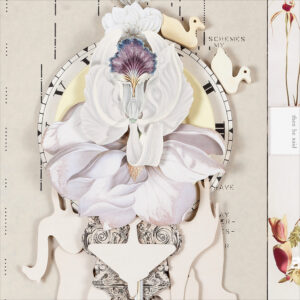 project in 2024. His “Wildflowers” albums are 30-minute studio recordings, each with a featured pianist and a guest artist. The albums are conceived, rehearsed, recorded, edited, mastered and issued in a single week. Obviously, the music is initially released on streaming services, but the first volume—featuring pianist Sullivan Fortner and vocalist Cécile McLorin Salvant—was recently released on CD and LP. The follow-up, featuring Joey Calderazzo on piano and Ingrid Jensen on flugelhorn, should be released on physical media by Edition Records sometime this year. After that, Elling plans to produce these recordings on his own label. There are at least two more volumes in the works, and Elling told me that conflicting artist schedules were the biggest problem with making these recordings. Despite the accelerated production schedule, the finished recordings are poised and elegant. As the big recording companies continue to fall, Kurt Elling’s unique vision may be the direction for music and distribution in the future. Audacious? Indeed.
project in 2024. His “Wildflowers” albums are 30-minute studio recordings, each with a featured pianist and a guest artist. The albums are conceived, rehearsed, recorded, edited, mastered and issued in a single week. Obviously, the music is initially released on streaming services, but the first volume—featuring pianist Sullivan Fortner and vocalist Cécile McLorin Salvant—was recently released on CD and LP. The follow-up, featuring Joey Calderazzo on piano and Ingrid Jensen on flugelhorn, should be released on physical media by Edition Records sometime this year. After that, Elling plans to produce these recordings on his own label. There are at least two more volumes in the works, and Elling told me that conflicting artist schedules were the biggest problem with making these recordings. Despite the accelerated production schedule, the finished recordings are poised and elegant. As the big recording companies continue to fall, Kurt Elling’s unique vision may be the direction for music and distribution in the future. Audacious? Indeed.
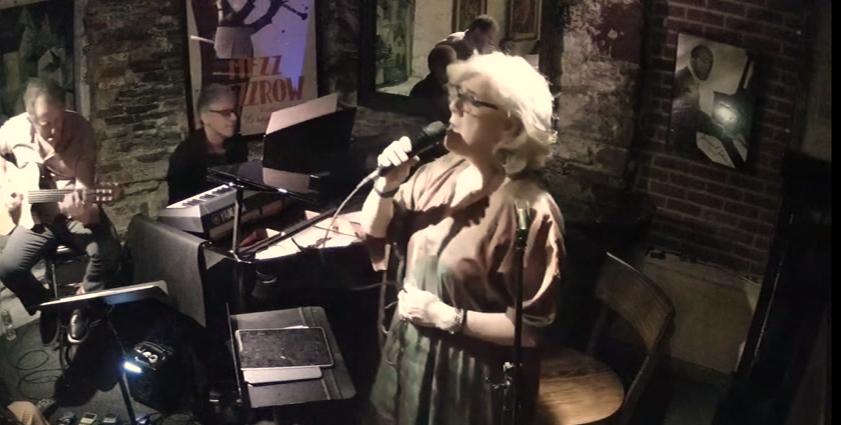
ARTISTS: Kate McGarry, Keith Ganz, Gary Versace
DATE: May 11, 2025
VENUE: Mezzrow, New York City
PERSONNEL: Kate McGarry (v); Keith Ganz (g); Gary Versace (p,kyb).
Several years ago, Kate McGarry and Keith Ganz decided to leave New York City, and just like Henry Nemo‘s birdies, they turned about and made a bee-line for the South. Specifically, they landed in Durham, North Carolina, where they perform on a fairly regular basis. Their friend and colleague, Gary Versace joined them for a brief concert tour with performances in Durham, the Deer Head Inn, New Jersey and Mezzrow in Greenwich Village. It had been over 5 years since McGarry and Ganz had performed in New York, and Mezzrow sold out both sets of a Mother’s Day engagement. I was not in New York for this concert, but watching the livestream held the distinct advantage of being able to watch and review both sets. The trio revisited several pieces that they had recorded since the last visit to NYC and added a few new favorites.
The first set opened with McGarry’s haunted revision of Irving Berlin‘s “Let’s Face the Music and Dance”, which focused attention on Berlin’s verbal imagery, while inspiring moody and introspective solos. McGarry’s free melodic variation soared over the intense background, and when the arrangement segued into a vamp, she improvised a brilliant series of melodies for the key words “Let’s Dance”. Next came a rant from the memoirs of pianist Hal Galper on the tricky business of marketing jazz musicians, and the power of McGarry’s recitation suddenly released into Paul Simon‘s “Feelin’ Groovy”. Ganz and Versace held onto the intensity through the theme statement before moving into a series of guitar/piano exchanges. McGarry found a unique tribute for her mother in Tadd Dameron‘s “If You Could See Me Now” via a Latin arrangement based on a classic Carmen McRae recording. Without changing a word, McGarry transformed the song’s message from romantic to maternal love. McGarry’s solo jumped back and forth between lyrics and scat, while covering a wide range of vocal timbres (including a surprising quote of the verse from “Stardust”!) McGarry combined the Keith Jarrett original “My Song” with Mary Oliver‘s inspirational poem, “Wild Geese”, and the result was a stunning homage to Jarrett’s amazing legacy. The tension was released with a delightful arrangement of “Fascinating Rhythm”. The trio had lots of fun running through the Gershwin‘s treacherous obstacle course of clever rhymes and crossing rhythms (and just in case you’ve wondered what a “fliver” is, I looked it up: it’s a broken-down car.) The set closed with a beautiful love anthem called “Happiness All the Time”, that was dedicated to Theo Bleckmann and his husband. And while few recognized it at the time, that tune was connected to the opening tune of the second set.
Before gay marriage was legalized in the US, McGarry transformed the Rodgers and Hammerstein song, “We Kiss in the Shadows” into an anthem for the cause. When she reprised the song at Mezzrow, it had a different feeling that it had 10 years ago. If we thought that the issue had finally been settled, we now have the fear of fighting the battle again. Through the music, McGarry, Ganz and Versace subtly reminded us that few things may be final in these uncertain times. Next came “Tis Autumn” (with the lyric I quoted above) in a charming, light-hearted arrangement. McGarry stretched the time like a big piece of taffy, while luxuriating in the rustic imagery. As McGarry sang, Ganz and Versace kept the accompaniment as a simple two-beat. Then the two instrumentalists presented strongly contrasting statements on the changes, Ganz with a dazzling sequence of single-string ideas, and Versace with a solo full of octave doubles, and quick changes between his electric and acoustic keyboards. A rubato coda by McGarry brought the arrangement to a pleasing conclusion. McGarry had more fun with Tom Adair’s vintage lyrics to “Will You Still Be Mine”, offering a very funny set of new words to both the verse and chorus. She took sharper aim at modern times with the next two songs, an original called “GSC” (dealing with consumerism and image shaming) and Leonard Cohen‘s eternally-relevant “Anthem”. Before the hour-long set ended—and much too soon—the trio finished their recital with “Mister Sparkle,” Ganz’s modern contrafact on “What a Difference a Day Made”.
We’ve had to wait quite a while for Kate McGarry to return to our musical universe. Frankly, it’s been too long. Kate, Keith and Gary, please record a new album and make another, longer tour soon. We missed you.

ARTISTS: Terell Stafford Quintet
DATE: May 16, 2025
VENUE: Smoke, New York City
PERSONNEL: Terell Stafford (tp); Tim Warfield (ss,ts); Bruce Barth (p); David Wong (b); Johnathan Blake (d).
Comfortably ensconced in a week-long engagement at Smoke, the 9:00 Friday night set by the Terell Stafford Quintet was relaxed but still engaging. The members of the group have been close friends for many years, and they are very comfortable as they joke with each other onstage. Yet, when the music starts, they are united in their objective and dedicated to excellence. Stafford took advantage of the extended gig to call a few of his older compositions, and the band treated them with the same enthusiasm as when playing a new work. For example, on the opening number, “Kum-Ba-Yah” (not the old campfire song, but based on the same message) the band explored this 20+ year old work for a solid 15 minutes, and neither the inspiration nor the energy sagged for a moment. Starting with a vamp over a building press roll by Johnathan Blake, the lyric theme grew in intensity with each repetition. Stafford soloed first, with his soulful lines projected through a fat rich tone reminiscent of Clifford Brown and Freddie Hubbard. Blake was a marvel as his loose-limbed patterns engaged the ideas of the soloists. Tim Warfield‘s soprano sax tone pierced the air, while developing a series of incisive phrases. Bruce Barth opened his solo with superbly executed single lines before moving into passages of block chords. David Wong‘s bass solo maintained the energy with swinging melodic lines and outstanding tone. There was a brief recap of the melody before a vamp ushered in Blake for a stunning display of polyrhythms. Horace Silver‘s classic bop theme “Room 608” started out as a medium swing, but a calypso beat (originally intended to alternate with the swing feel) eventually took over as the main groove. Stafford’s solo over the shifting pattern was full of fireworks. Now on tenor, Warfield’s solo started lyrical but became more detached with Blake’s encouragement. Barth dug into the contrasting styles and sometimes blurred the lines between the two. “Favor” is Stafford’s personal statement of gratitude about his life and family. Fittingly, the piece opened with an extended unaccompanied trumpet solo, which displayed Stafford’s plentiful musical gifts. The composition proper opened with a soulful melody in 6/8 time, which would fit right into any African-American church service. Stafford’s solo with the band was lyric and flowing, before building to a passionate climax. Warfield presented his own testimonial with its own peaks and valleys. Barth’s statement was supportive instead of autobiographical, but the balance of approaches between the three soloists was surprisingly cohesive for an improvised performance.
The highlight of the set came next. I have said many times that Terell Stafford can raise the roof without effort, but he is at his best when he plays a ballad. Without an announcement, he picked up his horn and played the opening notes to Hoagy Carmichael‘s “Skylark”. After Stafford essayed the first eight bars alone, Barth joined in and the two men played the rest of the first chorus as a duet. Wong and Blake slipped in as Stafford began to spin poignant variations on the melody. His lovely tone told as much as the notes conveyed, and as the performance progressed, Stafford let the phrases flow longer to better convey the building emotions. Barth’s solo swang with great strength before Stafford returned for a brilliant final chorus split between thrilling high note passages, and tender gestures from the low and middle registers. Terell, would you please record a ballads album (preferably with strings?) The set closed with a classic blues from a fellow Philadelphia trumpeter, Lee Morgan. The Stafford Quintet enriched “Speedball” with quickly shifting dynamics and a slashing, take-no-prisoners approach. Apparently, before the set, Stafford was given strict instructions that the set was to go no longer than 60 minutes to accommodate the livestream. The quintet actually played 65 minutes, but as a livestream viewer, I had no complaints. I doubt that anyone else in the club or in cyberspace minded, either.
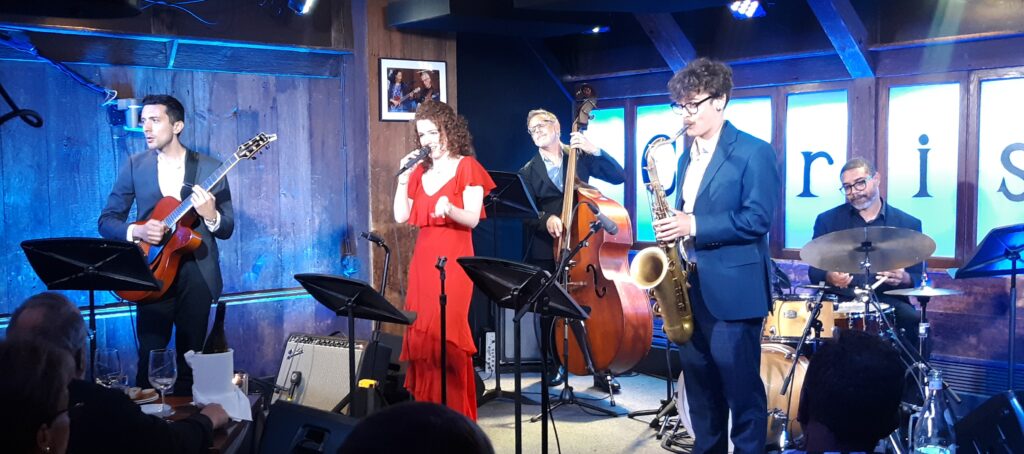
ARTISTS: April Varner with the Matthew Rotker-Lynn Quartet
DATE: May 31, 2025
VENUE: Chris’ Jazz Café; Philadelphia
PERSONNEL: April Varner (v); Aidan McKeon (ts); Matthew Rotker-Lynn (g); Dave Brodie (b); Wayne Smith, Jr. (d)
Collections of unrelated concert reviews do not carry a recurring theme (how could they?), but the last five concerts that I have attended had one interesting element in common: somewhere in the program, the featured artists re-arranged a vintage piece of the jazz repertoire to make the music relevant to a contemporary audience. While creating revitalized settings is not a new practice, it is a very effective way to introduce the music to novice—and quite often seasoned—listeners. Renee Rosnes’ revision of Blue Note standards is a regular part of Artemis’ repertoire, Kurt Elling is currently touring a Weather Report tribute complete with new vocalese lyrics, Kate McGarry combines familiar standards with poetry and prose, the Terell Stafford Quintet discovered a Latin feel within Horace Silver’s “Room 608”, and in the most recent example, the exciting young vocalist April Varner opened her first set at Chris’ Jazz Café with a stunning remake of an obscure Ella Fitzgerald song, “When I Get Low, I Get High“.
Even the most die-hard Ella fans could be excused for not knowing this tune: it was recorded in April 1936 on Fitzgerald’s fourth recording date, and except for the original 78, it has only been released on chronological reissues of her complete Chick Webb recordings. Far removed from its original setting as a medium-tempo minor key swing vehicle, Varner opened with a rubato chorus for her voice and Dave Brodie‘s bass. While in the slow tempo, Varner emphasized the lyric’s theme of independence and self-reliance, but then the tempo took off like a rocket, featuring burning solos by Varner, tenor saxophonist Aidan McKeon, and guitarist Matthew Rotker-Lynn. The 2023 winner of the Ella Fitzgerald Jazz Vocal Competition, Varmer has a Fitzgerald tribute album in the works. She has learned well from Fitzgerald’s recorded legacy, but she is far from an Ella clone. She has amalgamated several primary influences (both vocal and instrumental) to create her unique persona. Her melodic variations are both creative and tasteful, and her scat improvisations feature fine original melodies, daring harmonic explorations, and abundant swing. The two vocalists share exceptional diction and vivid musical imaginations.
Rotker-Lynn’s backing quartet combined musicians from New York and Philadelphia. The standout was McKeon, whose exuberance for playing appeared in every solo. Still a university student, he is already making his place on the New York scene, and will doubtlessly become a major player in the coming years. Rotker-Lynn’s reserved solo style made him a natural foil for McKeon’s spirited improvisations. His comping behind the other soloists was exemplary, and he displayed his skill as an accompanist later in the evening on a brief duet with Varner on Paul Simon’s “April, Come She Will”. Dave Brodie and Wayne Smith, Jr. are both Philly veterans (Brodie headlined a group at Chris’ earlier in the week). As a rhythm team, they were unbeatable, setting and maintaining grooves, and adapting their styles to reflect the changing genres. Brodie’s opening Mingus-like duet with Varner was stunning, as was Smith’s exquisite shading with brushes and snares on the Latin-flavored “Night and Day”.
Varner’s set list encompassed standards sung by Fitzgerald and Frank Sinatra, along with selections from her debut album, “April by April Varner“. In the first set, she created an original blues using words suggested by the audience. She successfully inserted four of the five words but may have spent a little too much time singing about a former romance. Elsewhere in the first set, there were three songs from the Duke Ellington library, Duke’s swinging “Love You Madly”, Billy Strayhorn‘s proto-bop “Clementine” and Juan Tizol‘s barn burner “Caravan”. Her best ballad reading was on George Gershwin‘s “Someone to Watch Over Me” where she let Ira’s lyrics predominate over vocal fireworks.
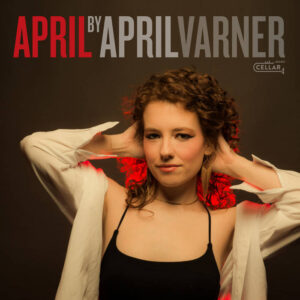 Readers interested in hearing Varner are hereby encouraged to seek out her debut album, featuring 11 songs with the word “April” in the title. It is a challenging concept to realize, even with a keyword that doubles as a name and month. “I’ll Remember April” and “April in Paris” are present (featuring Benny Benack III and Caelan Cardello, respectively) plus unexpected gems from Pat Metheny (“April Joy”), Prince (“Sometimes it Snows in April”) and another rara avis introduced on a pop single by Sarah Vaughan (“April, Give Me One More Day”). The late Russell Malone appeared on two tracks (including “April, Come She Will”), Dayna Stephens was a great partner for Benack on the front line, while Reuben Rogers and Miguel Russell anchored the rhythm section. Varner is in exceptional form throughout, matching wits and talent with her esteemed colleagues. Whether on disc or stage, April Varner displays the exceptional musicianship that should propel her into an exciting career.
Readers interested in hearing Varner are hereby encouraged to seek out her debut album, featuring 11 songs with the word “April” in the title. It is a challenging concept to realize, even with a keyword that doubles as a name and month. “I’ll Remember April” and “April in Paris” are present (featuring Benny Benack III and Caelan Cardello, respectively) plus unexpected gems from Pat Metheny (“April Joy”), Prince (“Sometimes it Snows in April”) and another rara avis introduced on a pop single by Sarah Vaughan (“April, Give Me One More Day”). The late Russell Malone appeared on two tracks (including “April, Come She Will”), Dayna Stephens was a great partner for Benack on the front line, while Reuben Rogers and Miguel Russell anchored the rhythm section. Varner is in exceptional form throughout, matching wits and talent with her esteemed colleagues. Whether on disc or stage, April Varner displays the exceptional musicianship that should propel her into an exciting career.